Ruiyi Yang
Divide by Question, Conquer by Agent: SPLIT-RAG with Question-Driven Graph Partitioning
May 20, 2025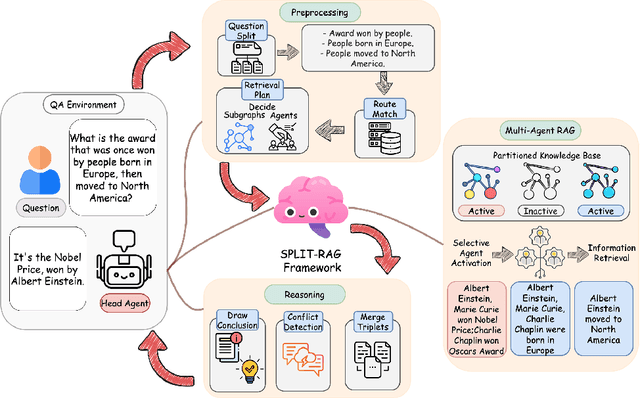
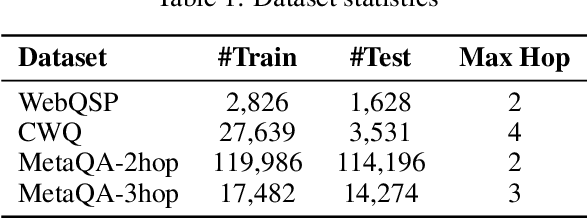
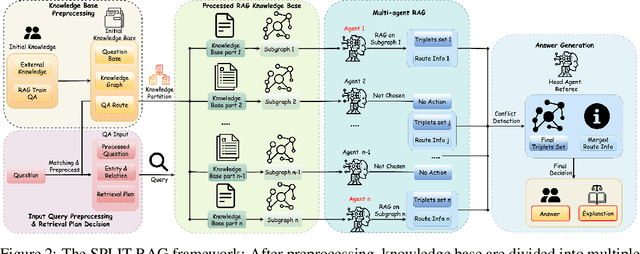
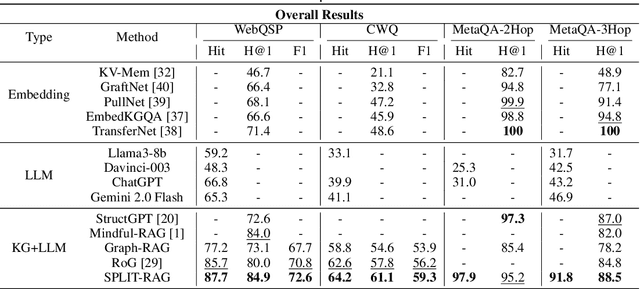
Abstract:Retrieval-Augmented Generation (RAG) systems empower large language models (LLMs) with external knowledge, yet struggle with efficiency-accuracy trade-offs when scaling to large knowledge graphs. Existing approaches often rely on monolithic graph retrieval, incurring unnecessary latency for simple queries and fragmented reasoning for complex multi-hop questions. To address these challenges, this paper propose SPLIT-RAG, a multi-agent RAG framework that addresses these limitations with question-driven semantic graph partitioning and collaborative subgraph retrieval. The innovative framework first create Semantic Partitioning of Linked Information, then use the Type-Specialized knowledge base to achieve Multi-Agent RAG. The attribute-aware graph segmentation manages to divide knowledge graphs into semantically coherent subgraphs, ensuring subgraphs align with different query types, while lightweight LLM agents are assigned to partitioned subgraphs, and only relevant partitions are activated during retrieval, thus reduce search space while enhancing efficiency. Finally, a hierarchical merging module resolves inconsistencies across subgraph-derived answers through logical verifications. Extensive experimental validation demonstrates considerable improvements compared to existing approaches.
KG-IRAG: A Knowledge Graph-Based Iterative Retrieval-Augmented Generation Framework for Temporal Reasoning
Mar 19, 2025Abstract:Graph Retrieval-Augmented Generation (GraphRAG) has proven highly effective in enhancing the performance of Large Language Models (LLMs) on tasks that require external knowledge. By leveraging Knowledge Graphs (KGs), GraphRAG improves information retrieval for complex reasoning tasks, providing more precise and comprehensive retrieval and generating more accurate responses to QAs. However, most RAG methods fall short in addressing multi-step reasoning, particularly when both information extraction and inference are necessary. To address this limitation, this paper presents Knowledge Graph-Based Iterative Retrieval-Augmented Generation (KG-IRAG), a novel framework that integrates KGs with iterative reasoning to improve LLMs' ability to handle queries involving temporal and logical dependencies. Through iterative retrieval steps, KG-IRAG incrementally gathers relevant data from external KGs, enabling step-by-step reasoning. The proposed approach is particularly suited for scenarios where reasoning is required alongside dynamic temporal data extraction, such as determining optimal travel times based on weather conditions or traffic patterns. Experimental results show that KG-IRAG improves accuracy in complex reasoning tasks by effectively integrating external knowledge with iterative, logic-based retrieval. Additionally, three new datasets: weatherQA-Irish, weatherQA-Sydney, and trafficQA-TFNSW, are formed to evaluate KG-IRAG's performance, demonstrating its potential beyond traditional RAG applications.
Model-free Estimation of Latent Structure via Multiscale Nonparametric Maximum Likelihood
Oct 29, 2024Abstract:Multivariate distributions often carry latent structures that are difficult to identify and estimate, and which better reflect the data generating mechanism than extrinsic structures exhibited simply by the raw data. In this paper, we propose a model-free approach for estimating such latent structures whenever they are present, without assuming they exist a priori. Given an arbitrary density $p_0$, we construct a multiscale representation of the density and propose data-driven methods for selecting representative models that capture meaningful discrete structure. Our approach uses a nonparametric maximum likelihood estimator to estimate the latent structure at different scales and we further characterize their asymptotic limits. By carrying out such a multiscale analysis, we obtain coarseto-fine structures inherent in the original distribution, which are integrated via a model selection procedure to yield an interpretable discrete representation of it. As an application, we design a clustering algorithm based on the proposed procedure and demonstrate its effectiveness in capturing a wide range of latent structures.
SSTKG: Simple Spatio-Temporal Knowledge Graph for Intepretable and Versatile Dynamic Information Embedding
Feb 19, 2024Abstract:Knowledge graphs (KGs) have been increasingly employed for link prediction and recommendation using real-world datasets. However, the majority of current methods rely on static data, neglecting the dynamic nature and the hidden spatio-temporal attributes of real-world scenarios. This often results in suboptimal predictions and recommendations. Although there are effective spatio-temporal inference methods, they face challenges such as scalability with large datasets and inadequate semantic understanding, which impede their performance. To address these limitations, this paper introduces a novel framework - Simple Spatio-Temporal Knowledge Graph (SSTKG), for constructing and exploring spatio-temporal KGs. To integrate spatial and temporal data into KGs, our framework exploited through a new 3-step embedding method. Output embeddings can be used for future temporal sequence prediction and spatial information recommendation, providing valuable insights for various applications such as retail sales forecasting and traffic volume prediction. Our framework offers a simple but comprehensive way to understand the underlying patterns and trends in dynamic KG, thereby enhancing the accuracy of predictions and the relevance of recommendations. This work paves the way for more effective utilization of spatio-temporal data in KGs, with potential impacts across a wide range of sectors.
Gaussian Process Regression under Computational and Epistemic Misspecification
Dec 14, 2023Abstract:Gaussian process regression is a classical kernel method for function estimation and data interpolation. In large data applications, computational costs can be reduced using low-rank or sparse approximations of the kernel. This paper investigates the effect of such kernel approximations on the interpolation error. We introduce a unified framework to analyze Gaussian process regression under important classes of computational misspecification: Karhunen-Lo\`eve expansions that result in low-rank kernel approximations, multiscale wavelet expansions that induce sparsity in the covariance matrix, and finite element representations that induce sparsity in the precision matrix. Our theory also accounts for epistemic misspecification in the choice of kernel parameters.
Alignment of Density Maps in Wasserstein Distance
May 21, 2023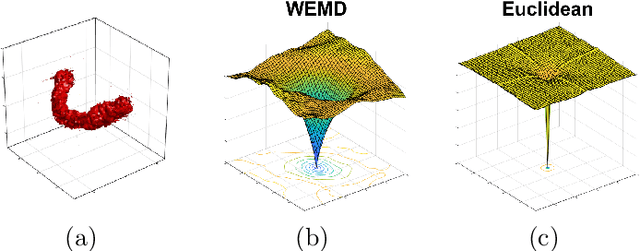


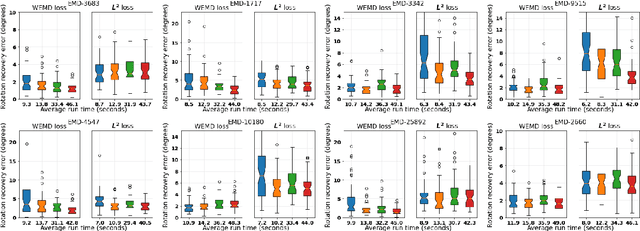
Abstract:In this paper we propose an algorithm for aligning three-dimensional objects when represented as density maps, motivated by applications in cryogenic electron microscopy. The algorithm is based on minimizing the 1-Wasserstein distance between the density maps after a rigid transformation. The induced loss function enjoys a more benign landscape than its Euclidean counterpart and Bayesian optimization is employed for computation. Numerical experiments show improved accuracy and efficiency over existing algorithms on the alignment of real protein molecules. In the context of aligning heterogeneous pairs, we illustrate a potential need for new distance functions.
Mathematical Foundations of Graph-Based Bayesian Semi-Supervised Learning
Jul 03, 2022

Abstract:In recent decades, science and engineering have been revolutionized by a momentous growth in the amount of available data. However, despite the unprecedented ease with which data are now collected and stored, labeling data by supplementing each feature with an informative tag remains to be challenging. Illustrative tasks where the labeling process requires expert knowledge or is tedious and time-consuming include labeling X-rays with a diagnosis, protein sequences with a protein type, texts by their topic, tweets by their sentiment, or videos by their genre. In these and numerous other examples, only a few features may be manually labeled due to cost and time constraints. How can we best propagate label information from a small number of expensive labeled features to a vast number of unlabeled ones? This is the question addressed by semi-supervised learning (SSL). This article overviews recent foundational developments on graph-based Bayesian SSL, a probabilistic framework for label propagation using similarities between features. SSL is an active research area and a thorough review of the extant literature is beyond the scope of this article. Our focus will be on topics drawn from our own research that illustrate the wide range of mathematical tools and ideas that underlie the rigorous study of the statistical accuracy and computational efficiency of graph-based Bayesian SSL.
Uniform Consistency in Nonparametric Mixture Models
Aug 31, 2021
Abstract:We study uniform consistency in nonparametric mixture models as well as closely related mixture of regression (also known as mixed regression) models, where the regression functions are allowed to be nonparametric and the error distributions are assumed to be convolutions of a Gaussian density. We construct uniformly consistent estimators under general conditions while simultaneously highlighting several pain points in extending existing pointwise consistency results to uniform results. The resulting analysis turns out to be nontrivial, and several novel technical tools are developed along the way. In the case of mixed regression, we prove $L^1$ convergence of the regression functions while allowing for the component regression functions to intersect arbitrarily often, which presents additional technical challenges. We also consider generalizations to general (i.e. non-convolutional) nonparametric mixtures.
Posterior Contraction Rates for Graph-Based Semi-Supervised Classification
Aug 26, 2020Abstract:This paper studies Bayesian nonparametric estimation of a binary regression function in a semi-supervised setting. We assume that the features are supported on a hidden manifold, and use unlabeled data to construct a sequence of graph-based priors over the regression function restricted to the given features. We establish contraction rates for the corresponding graph-based posteriors, interpolated to be supported over regression functions on the underlying manifold. Minimax optimal contraction rates are achieved under certain conditions. Our results provide novel understanding on why and how unlabeled data are helpful in Bayesian semi-supervised classification.
Local Regularization of Noisy Point Clouds: Improved Global Geometric Estimates and Data Analysis
Apr 06, 2019



Abstract:Several data analysis techniques employ similarity relationships between data points to uncover the intrinsic dimension and geometric structure of the underlying data-generating mechanism. In this paper we work under the model assumption that the data is made of random perturbations of feature vectors lying on a low-dimensional manifold. We study two questions: how to define the similarity relationship over noisy data points, and what is the resulting impact of the choice of similarity in the extraction of global geometric information from the underlying manifold. We provide concrete mathematical evidence that using a local regularization of the noisy data to define the similarity improves the approximation of the hidden Euclidean distance between unperturbed points. Furthermore, graph-based objects constructed with the locally regularized similarity function satisfy better error bounds in their recovery of global geometric ones. Our theory is supported by numerical experiments that demonstrate that the gain in geometric understanding facilitated by local regularization translates into a gain in classification accuracy in simulated and real data.
 Add to Chrome
Add to Chrome Add to Firefox
Add to Firefox Add to Edge
Add to Edge